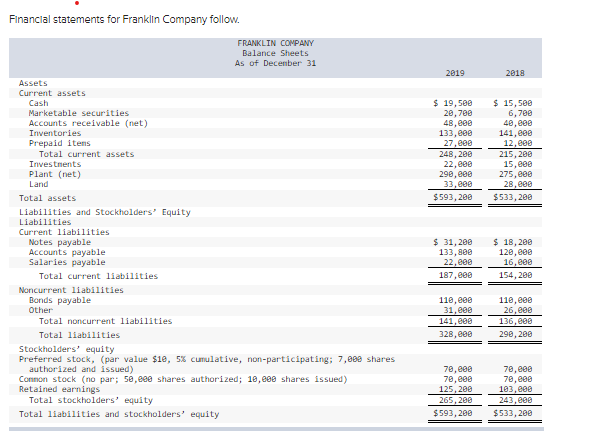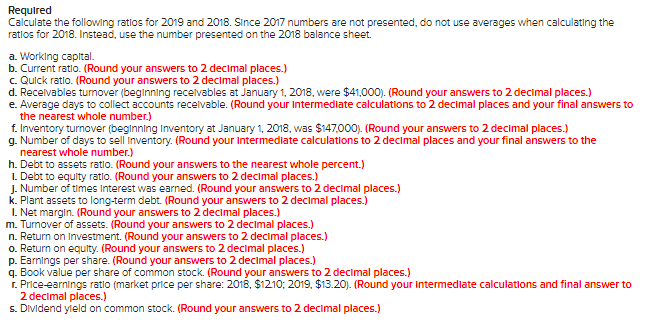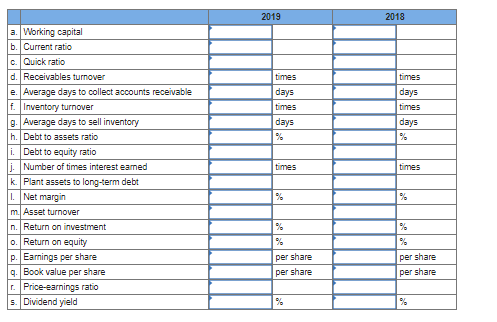



Financial statements for Franklin Company follow. FRANKLIN COMPANY Balance Sheets As of December 31 2019 2018 $ 19,500 28,780 48,00 133,000 27,000 248,200 22,eee 290, eee 33,000 $593,200 $ 15,5ee 6,700 40,000 141,600 12,000 215,280 15,00 275,000 28,eee $533,280 Assets Current assets Cash Marketable securities Accounts receivable (net) Inventories Prepaid itens Total current assets Investments Plant (net) Land Total assets Liabilities and Stockholders' Equity Liabilities Current liabilities Notes payable Accounts payable Salaries payable Total current liabilities Noncurrent liabilities Bonds payable Other Total noncurrent liabilities Total liabilities Stockholders' equity Preferred stock, (par value $12, 5% cumulative, non-participating; 7,882 shares authorized and issued) Connon stock (no par: 50,eee shares authorized; 18,eee shares issued) Retained earnings Total stockholders' equity Total liabilities and stockholders' equity $ 31,280 133,800 22,eee 187, eee 18,280 120,000 16,000 154,200 118,eee 31, eee 141,00 328, eee 118, eee 26, eee 136, eee 290, 280 70,000 70,000 125,200 265,280 $593,280 70,eee 70,000 183, eee 243,00 $533, 288 2018 $280,eee 6,480 286, 480 FRANKLIN COMPANY Statements of Income and Retained Earnings For the Years Ended December 31 2019 Revenues Sales (net) $380, eee Other revenues 9,400 Total revenues 389,480 Expenses Cost of goods sold 158,eee Selling, general, and administrative 62,00 Interest expense 10,100 Income tax expense 58,00 Total expenses 280, 100 Net earnings (net income) 29, 300 Retained earnings, January 1 103,eee Less: Preferred stock dividends 3,500 Common stock dividends 3,600 Retained earnings, December 31 $125,280 124.000 57,600 9,380 57.000 247, 300 39,180 71,00 3,500 3,688 $183, een Required Calculate the following ratios for 2019 and 2018. Since 2017 numbers are not presented, do not use averages when calculating the ratios for 2018. Instead, use the number presented on the 2018 balance sheet. a. Working capital. b. Current ratio. (Round your answers to 2 decimal places.) Quick ratio. (Round your answers to 2 decimal places.) d. Receivables tumover (beginning recelvables at January 1, 2018, were $41.000). (Round your answers to 2 decimal places.) e. Average days to collect accounts receivable. (Round your Intermediate calculations to 2 decimal places and your final answers to the nearest whole number.) f. Inventory turnover (beginning Inventory at January 1, 2018, was $147.000). (Round your answers to 2 decimal places.) g. Number of days to sell Inventory. (Round your intermediate calculations to 2 decimal places and your final answers to the nearest whole number.) h. Debt to assets ratio. (Round your answers to the nearest whole percent.) 1. Debt to equity ratio. (Round your answers to 2 decimal places.) J. Number of times Interest was earned. (Round your answers to 2 decimal places.) k. Plant assets to long-term debt. (Round your answers to 2 decimal places.) 1. Net margin. (Round your answers to 2 decimal places.) m. Tumover of assets. (Round your answers to 2 decimal places.) n. Return on Investment. (Round your answers to 2 decimal places.) o. Return on equity. (Round your answers to 2 decimal places.) p. Earnings per share. (Round your answers to 2 decimal places.) q. Book value per share of common stock. (Round your answers to 2 decimal places.) 1. Price earnings ratio (market price per share: 2016, $12.10: 2019, $13.20). (Round your intermediate calculations and final answer to 2 decimal places.) s. Dividend yield on common stock. (Round your answers to 2 decimal places.) 2019 2018 times days times times days times days % days a. Working capital b. Current ratio c. Quick ratio d. Receivables turnover e. Average days to collect accounts receivable f. Inventory turnover 9. Average days to sell inventory h. Debt to assets ratio i. Debt to equity ratio j. Number of times interest eamed k. Plant assets to long-term debt Net margin m. Asset turnover n. Return on investment 0. Return on equity p. Earnings per share 9. Book value per share Price-earnings ratio 5. Dividend yield times times % % % per share per share per share per share










